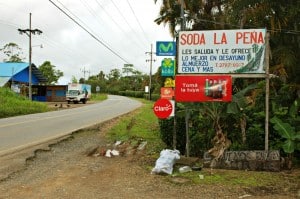 By: Amanda Froelich,
By: Amanda Froelich,
True Activist.
A bounty of vibrantly-colored veggie-filled rice spooned next to a hearty helping of seasoned legumes and a quarter of fresh eggs is placed before you. The steaming aroma of seasoning and spices wafts through the fresh air, greeting your senses in ecstasy. Chirps and calls echo through the green jungle spilling around the cozy restaurant, and all there is to do is forget the essence of time and enjoy the gift before you.
The traditional Gaillo Pinto (literally translated as colorful rooster) is a filling and delicious meal that serves as one of the official dishes of Costa Rica; Breakfast, lunch, and even dinner – it’s always a suitable time to enjoy the cultivated local foods that create this staple.
In the breezy jungle sitting across from smiling Tico’s, there’s nothing you can do but adopt the healthy mindset in such a cultural setting as the La Soda de Penna restaurant, absorbing lessons that are translated through the food and atmosphere.
1. Eat it Fresh
With the majority of the produce less than 5 hectares (10 acres) away, there’s a lot to say about the quality and freshness of the food. Tico’s (endearing term regarding native Costa Ricans) take pride in cultivating their own food – most of which is sold and grown at markets. The abundance of fresh soil, sun, and pure water makes the tropical setting an excellent climate for growing nourishing sustenance.
Eating at a local restaurant in Tina Maste is no exception to the excellent quality and service you’ll receive. Smoothies with real fruit (*gasps America*) can be prepared as easily as a dish of specially made sauteed vegetables and rice.
Foods that are consumed in their ripe and supremely fresh state have more nutrients and tend to have better taste.
2. Get it Local
With all the fresh produce one could need happily growing on the many farm lands in Costa Rica, there is little need to import the best foods for health. In fact, the majority of imported foods are the processed and packaged options being introduced to the modestly healthy people. As sad of a tragedy this may be, a large portion of what has been grown still goes to supply the many restaurants and tourist destinations. Keeping food local not only ensures it’s quality is intact, but that the environmental effect is much less than shipping it 20,000 miles to sit in a grocery store for 2 weeks.
3. Love your Food – Love what you do!
Some of the kindest, most integrity-filled people are the Ticos in Costa Rica. Wanting to ensure an excellent day for those whose their job is to help, they go above and beyond. Whether it’s in the hardware store or the cozy ‘La Soda de Penna’ diner, there is never a moment that lacks sincerity in its service. As the solo owner, chef, and waitress serves each of the three tables, at any moment you could ask for a favor and a grandson, sipping on a soda or smoothie, would slip off his stool and grab it for you. The grandmother running the restaurant, a strong elderly woman with beautifully wrinkled brown skin and a sweet, pearly smile embodies warmth and it’s obvious her pleasure to give draws in friends from all around.
The love is ingrained in the culture. In a place where it’s practically a free side dish on the menu, it’s a great reminder to eat with consciousness, appreciate the food, and put love into the work you are inspired to do as well.
4. Keep it Plant-based
Although there are plenty of non-vegetarian friendly options, the ability to grow a plethora of fresh fruits, vegetables, leafy greens, nuts, seeds, legumes, and local grains means there is abundant opportunity to utilize their benefits in the kitchens.
One of the major issues in developed worlds is the lack of fresh plant foods being consumed in the diet. Full of important vitamins, minerals, and alkalizing nutrients, they’re essential for health but unfortunately are missing.
Because of the simple and still modest economy, many refrain from consuming too much meat (usually 3x a week for the average Tico in San Salvador) and stay with the attainable plant-based foods. The plant based emphasis on their diets contributes to better heart health, balanced blood sugar, and adequate nutrition. Although Costa Rica is now beginning to deal with its own health epidemic in the larger cities due to Western influence, in smaller towns the nature-connected lifestyle still shows its beneficial effect.
5. Sometimes simplicity is best
Seated at a restaurant in Italy, for example, you’re like to experience the culture in the form of a 4-course meal, a fancy waiter, and a well-deserved expensive ticket. Costa Rica could quite well be the opposite. Being as it has scattered historical influence, it’s culinary background is much more modest.
Relying on passed down combinations of the foods available, the less wealthy country has not developed particular exotic dishes to trademark. This, however, could be somewhat of a blessing due to the fact that simple, wholesome food is much easier for the body to digest. Without excessive preparation and processing, it also retains more of its valuable nutrients. Finally, the opposite of lavish experience means that for travelers and those living on a budget, food is extremely accessible and affordable. Happily sustained on simple cuisine, the ability to appreciate simplicity in all matters of life is a gift, a lesson the natives know well.
6. Dine with Mindfulness
Aside from the more Western-influenced cities such as Perez Feledon, a small town like Tina Maste has seating outdoors to savor the light breeze. No television hangs down to distract customers, but instead the swaying of a beautiful Pejibaye branch, the begging of a forgotten dog, or the slow passing of rare cars gather the attention. It’s a beautiful reminder to be present not only in the process of consuming food (which helps digestion) but to be conscious of what is happening at every moment.
Truly, something is always happening; being distracted by a show or game, it’s easy to miss the subtle delights in life. So as you patiently wait for la quinta (check), you could soak up the dazzling sun beaming off of the white-tipped church or the friendly way the neighbor greets the waitress. There are many lessons from the slow moments enveloping the experience.
7. Eating CAN be Inexpensive
“I can’t eat healthy, it’s expensive”. Have you checked the price on a bag of beans or rice? Compared to refined foods and expensive packaged treats, unadulterated plant foods are actually some of the most affordable staples to pair with nutritious vegetables and whole grains in your household.
With an optimal focus on colorful fruits and vegetables, the staples one can base their health- inspired diet off of don’t need to be super foods from across the world. Like the humbled Ticos, use that foods that are accessible and compliment your health; with a satisfied mind and a balanced budget, it will be easier to consume nourishing fare.
Costa Rica is well known for its exotic beaches, adventure attractions, and lively jungle, but it seems even in the setting of a tiny town enjoying a nourishing meal, there are other valuable experiences to learn from abroad. Because food ties us in many ways to each other -culturally and emotionally – it’s an intriguing perspective to learn about how one can live a more balanced life by translating the lessons given by another culture into your own dining experience.


